Europe didn’t become a center for world economics with high standards of living by accident. Historical events in global development have favored this realm because of its physical geography and cultural factors. In southern Europe, the Greeks provided ideas, philosophy, and organization. Greek thinkers promoted the concept of democracy. The Romans carried the concept of empire to new levels. From about 150 BCE to 475 CE, the Romans brought many ideas together and controlled a large portion of Europe and North Africa. The Roman Empire introduced a common infrastructure to Europe. The Romans connected their world by building roads, bridges, aqueducts, and port facilities. They understood how to rule an empire. By taking advantage of the best opportunities of each region they controlled, they encouraged the best and most-skilled artisans to focus on what they did best. This created the specialization of goods and a market economy. No longer did everyone have to make everything for themselves. They could sell in the market what they produced and purchase products made by others, which would be of higher quality than what they could make at home. Regions that specialized in certain goods due to local resources or specialty skills could transport those goods to markets long distances away. The Roman Empire connected southern Europe and North Africa.
Figure 2.6 Extent of the Roman Empire, 117 CE
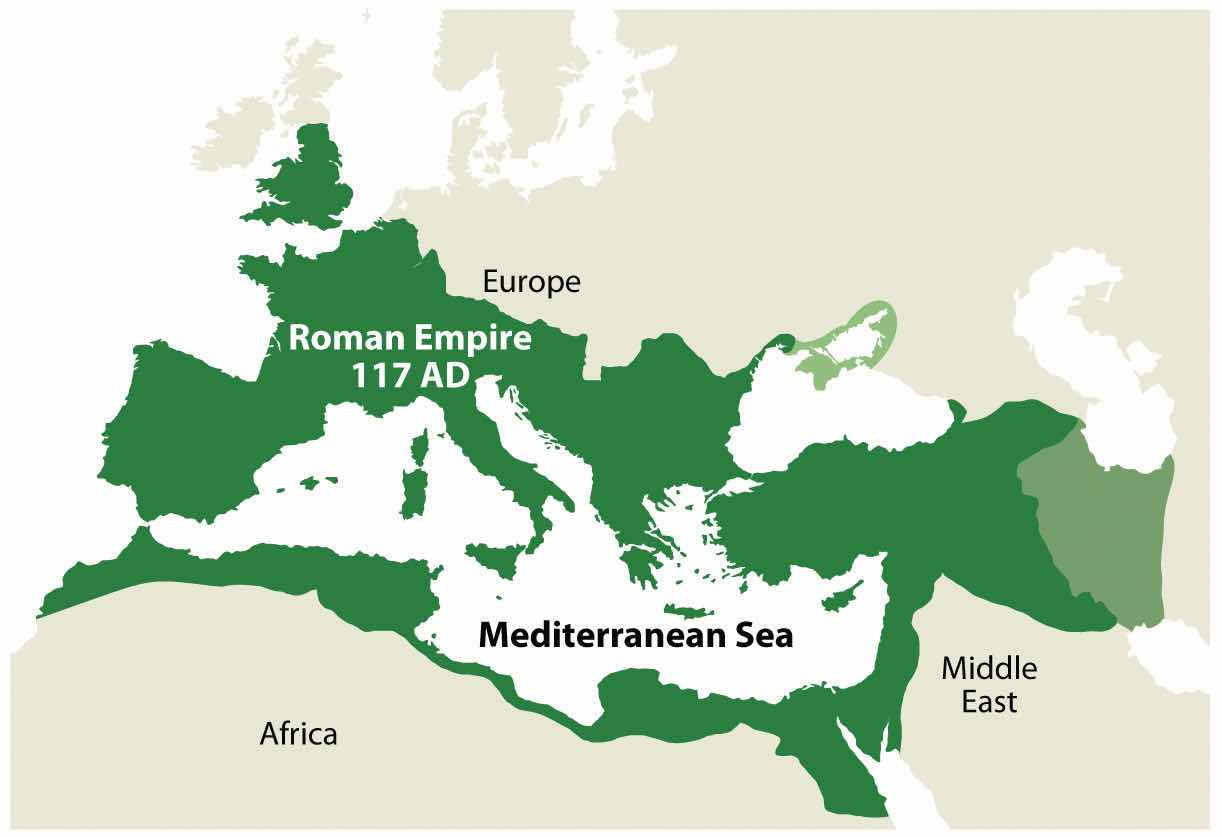
Source: Image courtesy of Tataryn77 2011, http://commons.wikimedia.org/wiki/File:Roman_Empire_117AD.jpg.
The Vikings of Scandinavia (Norway, Sweden, and Denmark; 900–1200 CE) are often inaccurately referred to as rogue bands of armed warriors who pillaged and plundered northern Europe. Though they were fierce warriors in battle, they were actually farmers, skilled craftsmen, and active traders. They developed trade routes throughout the north. Using their seafaring knowledge and skills, the Vikings used Europe’s waterways for transportation. They were the early developers of the northern world from Russia to Iceland and even to North America. They developed colonies in Iceland, Greenland, and what is present-day Canada. Their longships were renowned for versatility and provided an advantage on the sea. The Vikings made advances deep into Europe—all the way to Constantinople. History indicates that the Byzantine Empire employed Scandinavian Vikings as mercenaries.
In a general sense, the regions to the west of Scandinavia—such as Iceland, Scotland, Ireland, and Greenland—were targeted by the Norwegian Vikings. Southern regions such as England and France were more often destinations of the Danish Vikings. Russia and areas of Eastern Europe were standard trading grounds for the Swedish Vikings, though the different Viking groups could occasionally be found in the same destinations. The present-day Scandinavian countries were established after the main Viking period. The Vikings connected northern Europe with trade during the Dark Ages.
It wasn’t until after the Dark Ages of Europe ended that a rebirth of ideas, technology, and progress took hold. The Renaissance of the late fifteenth century prompted activity in Europe that changed the world. In 1492, Columbus and his three ships crossed the Atlantic to land on the shores of the Americas. This event symbolized the beginning of the era of European colonialismThe creation of colonies outside the home country, usually for the exploitation of natural resources or for economic gain., which only diminished after World War II. Colonialism’s effects remain in the colonies or protectorates that European countries still possess. Colonialism was fueled by the economic concept of mercantilismEconomic principle that outlines the drive for governments to gain wealth through the control of trade, which encouraged the expansion of colonial activity in Europe during the colonial era. that included the drive of governments to control trade, promoting the acquisition of wealth by the quick gain of gold or silver from their colonies.
Colonialism included the development of colonies outside the home country, usually for the expansion of imperial power and the exploitation of material gain. The building of larger ships and an understanding of sea travel allowed an exchange of new goods and ideas between continents. North and South America were opened up to the European explorers for colonial expansion. European colonialism brought newfound wealth from the colonies back to Europe. All the regions of the world outside Europe were targeted for colonialism. Africa was divided up, “Latin” America was created, and Asia became a target for resources and trade. The few powerful countries along the Atlantic coast of Europe began the drive to dominate their world. If you live in the Western Hemisphere, consider the language you speak and the borders of your country: both were most likely products of European colonialism. Most of the current political geographic boundaries were drawn up or shaped through colonial conflict or agreement.
The post-Renaissance era introduced a number of agricultural changes that impacted European food production. Before this time, most agricultural methods were primitive and labor intensive, but new technologies were introduced that greatly enhanced agricultural production. Plows, seeders, and harvesting technologies were introduced, and land reform and land ownership transitioned to adapt to the changing times. These innovations supported the expanding port cities that created urban markets for agricultural surpluses. Colonial ships returned from the colonies with new crops such as the potato that revolutionized crop production. This era’s progress in agricultural advancements is often referred to as the agrarian revolutionPost-Renaissance agricultural transformation that introduced new technology, crops, and land reforms that greatly enhanced agricultural production in Europe.. The agrarian revolution led to the industrial developments such as the steam tractor and steel implements that further advanced agricultural production worldwide.
Great Britain, being an island country, developed the world’s largest navy and took control of the seas. Their colonial reach extended from what is now Canada to Australia. The Industrial Revolution,Late-1700s shift to coal for energy, the steam engine for power, the smelting of iron, and the concept of mass production that changed how goods were produced. initiated in northern England in the late 1700s, introduced an industrial period that changed how humans produced products. The shift to coal for energy, the use of the steam engine for power, the smelting of iron, and the concept of mass production changed how goods were produced.
Figure 2.7
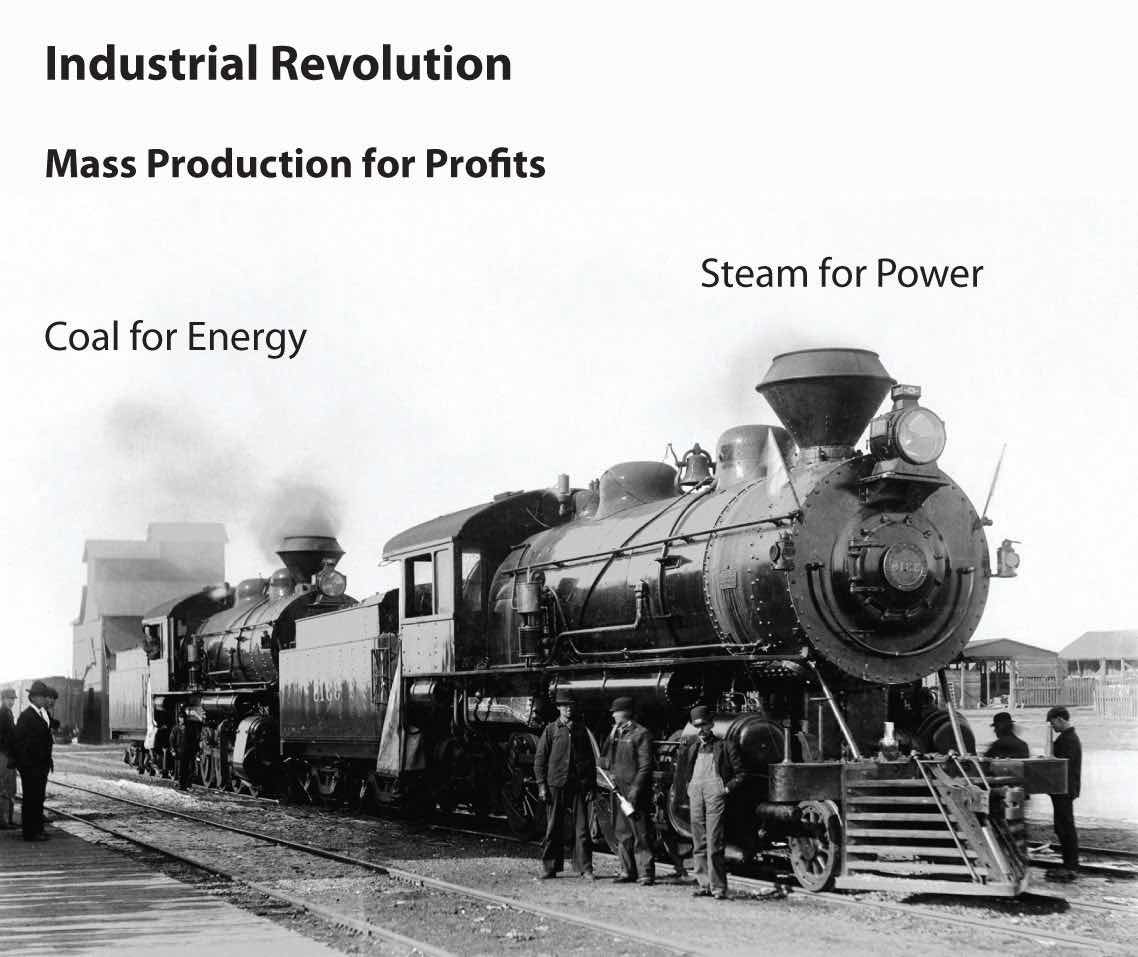
Mass production during the Industrial Revolution prompted a rural-to-urban shift in the population. Coal for energy and steam for power energized industrial activities.
The development of the steam-powered engine provided a mobile power source. Waterwheels powered by steep-flowing rivers or streams were an early source of power. With coal for fuel and steam for power, the engines of industry were mobile and moved full speed ahead. Power looms converted textiles such as cotton and wool into cloth. Powered by a steam engine, a power loom could operate twenty-four hours a day and could be located anywhere. Industrialization with cheap labor and adequate raw materials brought enormous wealth to the industrial leaders and their home countries.
With the mass production of goods and advancements in technology, there was a major shift in human labor. Fewer people were needed on the farms, and more workers were needed in factories. There was a large rural-to-urban shift in the human population. Europe experienced the development of the major cities of its realm during this period. In Britain, for example, in 1800 only 9 percent of the population lived in urban areas. By 1900, some 62 percent were urban dwellers. As of 2010, it is more than 90 percent. Europe, as a whole, is about 75 percent urban. As a comparison, the US population is about 80 percent urban.
As discussed in earlier sections, the rural-to-urban shift that began with the Industrial Revolution in Europe continues today in developing countries. The Industrial Revolution, which started in northern England’s Pennine mountain chain, rippled through Europe and across the Atlantic to the United States. The majority of countries in Europe are currently in stage 5 of the index of economic development. The five stages of the index of economic development illustrate a pattern of development and population dynamics for a country or region. The model outlines how rural societies with an agrarian economy in stage 1 can make the transition to stage 5: the stage that indicates an urban society with a consumer economy. As a general trend, when a country’s levels of industrial activity and urban growth rise, the outcome is usually a higher standard of living and smaller family sizes. Additionally, rural-to-urban shift takes place, driven by the pull of opportunities and advantages in the industrializing and urbanizing areas. Countries in stage 5 of the index have small families with a fertility rate below the replacement level. Their incomes, based on a consumer economy, are generally at high levels.
As Europe industrialized and progressed through the stages of the index of economic development, certain core regions reached the postindustrial stages earlier than others. Western Europe established a core industrial region with an extended periphery. The postindustrial activity in this core area continues today in four main centers of innovation: (1) Stuttgart in southern Germany, (2) Lyon in southeastern France, (3) Milan in northern Italy, and (4) Barcelona in northeastern Spain. These four industrial centers have been referred to by some as the Four Motors of Europe because they promote business and industry for the European community. The European core region extends as far as Stockholm in the north to Barcelona in the south.
Figure 2.8 The Core Region of Europe and the Four Centers of Industrial Activity
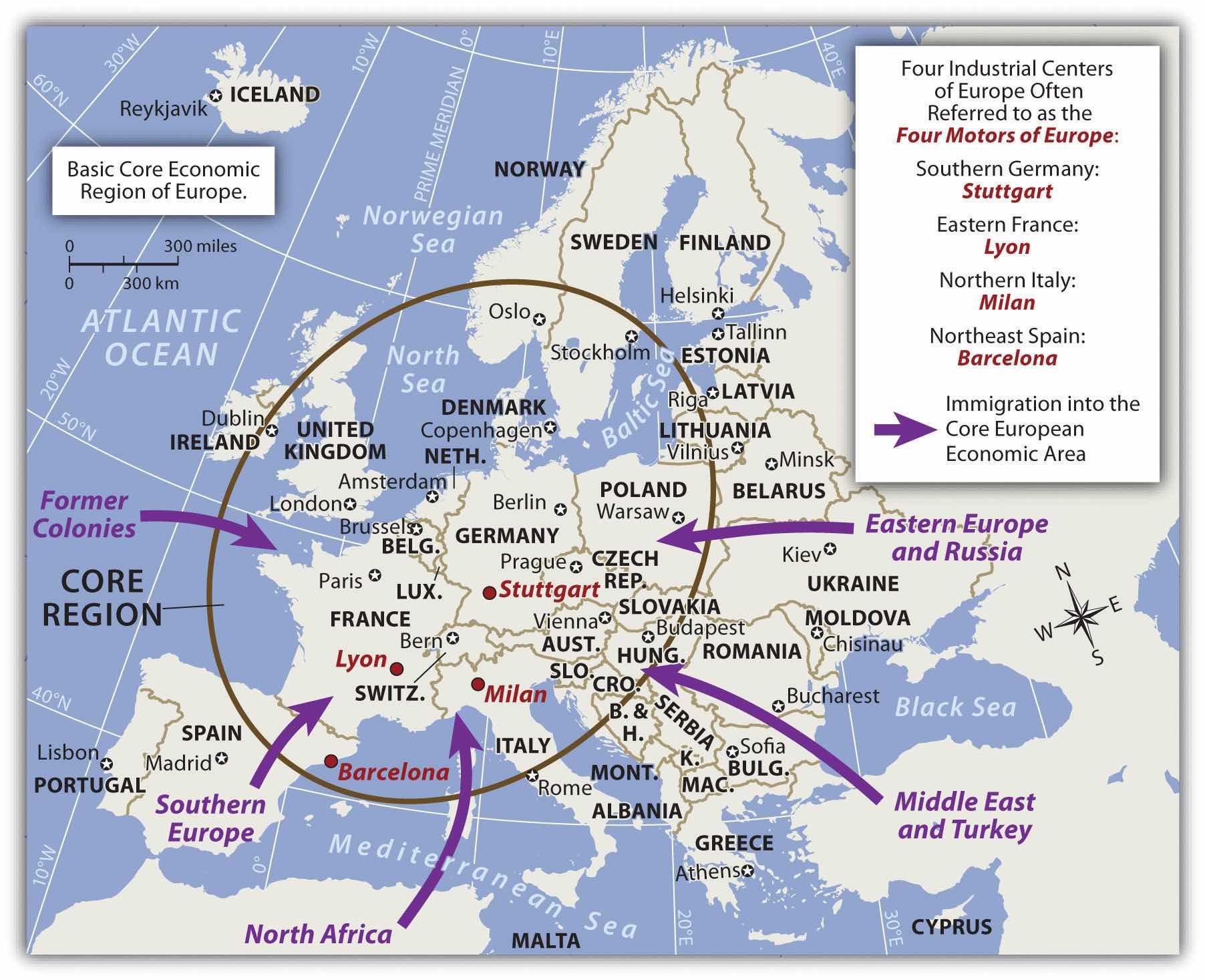
Attractive “pull” forces draw immigrants to the core economic area of Europe, seeking opportunity and advantage. “Push” forces cause people to leave an area due to negative cultural or environmental forces, and/or the lack of opportunity and advantage.
European urban development centered on port cities that had industrial activity. Ships could import raw materials, the factories could manufacture the goods, and the ships could export the products. A central business district (CBD)The core area of a city with a high concentration of business and commerce that was developed in early industrial cities to provide access to labor, factories, and the market. developed around these activities. Since walking was the main transportation mode, all business activities had to be located in the same vicinity. Banks, retail shops, food markets, and residential dwellings had to be close to the factories and port facilities. Modern cities emerged from this industrialization process, and Europe is one of the more urban realms on the planet.
Many European countries have one main primary city that is more than twice as large as their second city. The term primate cityA country’s largest city that is usually twice the size of the next largest city and is exceptionally expressive of the national culture and persona. indicates a city that is more than twice as large as their second city and exceptionally expressive of national feeling and heritage. One may instinctively think that the primate city is the same as the capital city of a country; this, however, is not always the case. For example, Washington, DC, is the US capital, but New York City is the country’s primate city. Primate cities represent a country’s persona and often are symbolic of the country’s heritage and character. Though common, not all countries of the world have a primate city. Financial and business centers in cities such as London, Rome, or Paris support the industrial activity that led to their development as primate cities. Most primate cities are ports or are located on a major river.
Consider the trend that the Industrial Revolution brought to Europe. Do you remember the population growth principle? This principle states that as countries industrialize and urbanize, family size naturally goes down and incomes traditionally go up. Integrate this with the rural-to-urban shift that occurs when countries progress through the five stages of the index of economic development. By understanding these basic trends, one can determine the average family size in Europe and why it is declining.
Because Europe is an urbanized realm, one can understand why family size in Europe is small. As a matter of fact, various countries in Europe have negative population growth rates. Family size in Spain and Italy is around 1.2, with the average family size in all of Europe at 1.4 children. The replacement rate to maintain an even population-growth pattern would be a fertility rate of about 2.1 children. Small families do not provide enough young people to cover the available entry-level service jobs. Europe, the United States, and Japan are all in stage 5 of the index of economic development and are facing low or negative population growth and a deficit in their cheap labor supply. As a core economic global power, Europe has experienced an increase in immigration. With a lower fertility rate and an increase in postindustrial activity, Europe is a magnet for people from poorer peripheral countries and even peripheral regions within Europe who are looking for opportunities and advantages.
With the planet’s human population increasing overall, one might think that a smaller family size is a positive trend. It may be, but there are problems along the way. If there are fewer young people in a community—fewer children and fewer people of employment age—consider how this affects the economic situation. With a declining European population, who will apply for the entry-level jobs? Economic core areas attract immigrants seeking opportunities and advantages. Europe follows this pattern. There has been increasing tension between the long-standing European cultural groups and immigrants from developing countries who often speak non-European languages or follow religions other than Christianity. The main religion of immigrants from North Africa or the Middle East is Islam, which is the fastest-growing religion in Europe.
There are six main reasons for declining family size in Europe:
The following problems arise with the decline in family size in Europe:
The agrarian revolution and the Industrial Revolution were powerful movements that altered human activity in many ways. New innovations in food production and the manufacturing of products transformed Europe, which in turn impacted the rest of the world. Even before the agrarian revolution was under way, other transitions in European political currents were undermining the established empire mentality fueled by warfare and territorial disputes. The political revolutionTransformation of Europe was a result of diverse actions focused on ending continual warfare for the control of territory and introducing peaceful agreements that recognized sovereignty of territories ruled by representative government structures. that transformed Europe was a result of diverse actions that focused on ending continual warfare for the control of territory and introducing peaceful agreements that recognized sovereignty of territory ruled by representative government structures. Various treaties and revolutions continued to shift the power from dictators and monarchs to the general populace. The Treaty of Westphalia in 1648 and those that followed helped establish a sense of peace and stability for Central Europe, which had been dominated by the Holy Roman Empire and competing powers. The Holy Roman Empire, which was centered on the German states of Cental Europe from 962–1806, should not be confused with the Roman Empire, which was based in Rome and ended centuries earlier. The French Revolution (1789–95) was an example of the political transformation taking place across Europe to establish democratic processes for governance.
The political revolution laid the groundwork for a sense of nationalism that transformed Europe into nation-statesPolitical unit in which the people (the nation) are unified under a similar heritage or culture and are under a unified common government (the state).. The term nation refers to a homogeneous group of people with a common heritage, language, religion, or political ambition. The term state refers to the government; for example, the United States has a State Department with a secretary of state. When nations and states come together, there is a true nation-state, wherein most citizens share a common heritage and a united government.
European countries have progressed to the point where the concept of forming or remaining a nation-state is a driving force in many political sectors. To state it plainly, most Europeans, and to an extent every human, want to be a member of a nation-state, where everyone is alike and shares the same culture, heritage, and government. The result of the drive for nation-states in Europe is an Italy for Italians, a united Germany for Germans, and a France for the French, for example. The truth is that this ideal goal is difficult to come by. Though the political borders of many European countries resemble nation-states, there is too much diversity within the nations to consider the ideal of creating a nation-state a true reality.
Various ethnic populations in Europe desire their own nation-states within their countries of residence. They want to devolve or separate from the larger state. The term devolutionThe process whereby regions within a country demand autonomy at the central government’s expense. refers to the process whereby regions or people within a state demand independence and autonomy at the central government’s expense. There are now a number of cases where devolution is occurring in Europe. For example, Scotland and Wales seek to devolve from the United Kingdom. The Basque region between Spain and France would like to have its own nation-state. Former Yugoslavia broke up into seven smaller nation-states. Various other minority groups in Europe seek similar arrangements. Thus both cohesive cultural forces and divisive cultural forces are active in the European community.
Cultural forces continually apply pressure on a country. Some of these cultural forces pull the nation together (centripetal forcesCultural forces that hold or bind a political unit together.) and others pull it apart (centrifugal forcesCultural forces that divide or separate people in a political unit.). Primary sources of these cultural forces include religion, language, ethnicity, politics, and economic conditions.
Figure 2.9
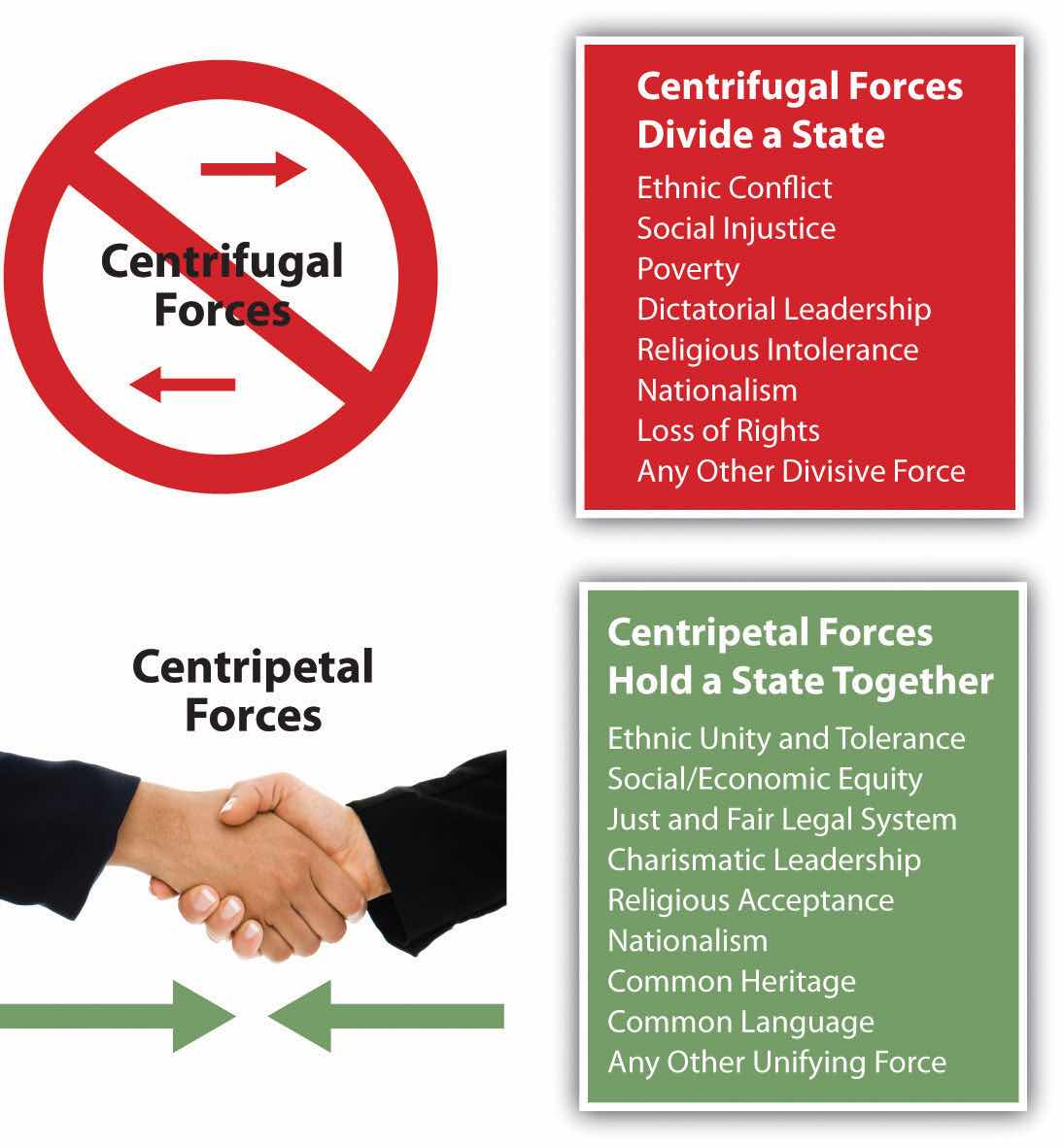
Centrifugal forces divide a state and centripetal forces hold a state together.
When there is division, conflict, or confrontation, the centrifugal forces are at play. When unification, agreement, or nationalism are being exercised, centripetal forces are evident. The sources that tie a country together can also be the sources that divide a country. Ethnic unity can be a positive force, while ethnic division and conflict can be a divisive force. If centrifugal forces become strong, the result may be outright civil war, as was seen in the United States in the 1860s. Unity can also be evident through national struggles, such as the nationalism displayed immediately after the 9/11 terrorist attacks in the United States. After the attacks, an outpouring of goodwill and agreement strengthened the bonds within the United States.
To understand our world, it is helpful to understand the cultural forces that are active in any one location. Disagreement, inequity, or injustice related to the cultural factors of ethnicity, religion, language, and economics of a region or country is the cause of most conflicts. The strong personalities that provide leadership can similarly prove to be powerful forces that either divide or unite a nation. An example of cultural forces in conflict in Europe can be found in Northern Ireland, where political forces use religious differences as a means of social division.
Europe has historically been considered a Christian realm. The three main branches of Christianity in Europe are Roman Catholic, Protestant, and Eastern Orthodox. Rome has been the geographical base for the Roman Catholic Church since the Roman Empire. Operating on the Romance language, Latin, the Catholic Church has provided southern Europe with a common religion for over 1,500 years.
The Roman Catholic Church split when Constantinople, now called Istanbul, gained preeminence. The Eastern Orthodox Church launched itself as the primary organization in the Slavic lands of Eastern Europe and Russia. The reformation of the fourteenth century, led by people such as Martin Luther, brought about the Protestant Reformation and a break with the Roman Catholic Church. Protestant churches have dominated northern Europe to this day.
Table 2.1 Three Main Language Groups
| Germanic Language Group (Found Mainly in Northern Europe) | Romance Language Group (Latin Based; Found Mainly in Southern Europe) | Slavic Language Group (Found Mainly in Eastern Europe) |
|---|---|---|
| English, Dutch, German | French, Italian, Spanish | Polish, Russian, Czech |
| Danish, Norwegian, Swedish | Portuguese, Romanian, Walloon | Ukrainian, Slovak, Slovene |
| Icelandic, Faroese, Frysian | Romancsh, Catalan, Provencal | Belarussian, Serbo-Croatian, Lusatian |
| Macedonian, Bulgarian |
Figure 2.10 Three Dominant Language Groups and Three Dominant Christian Denominations of Europe
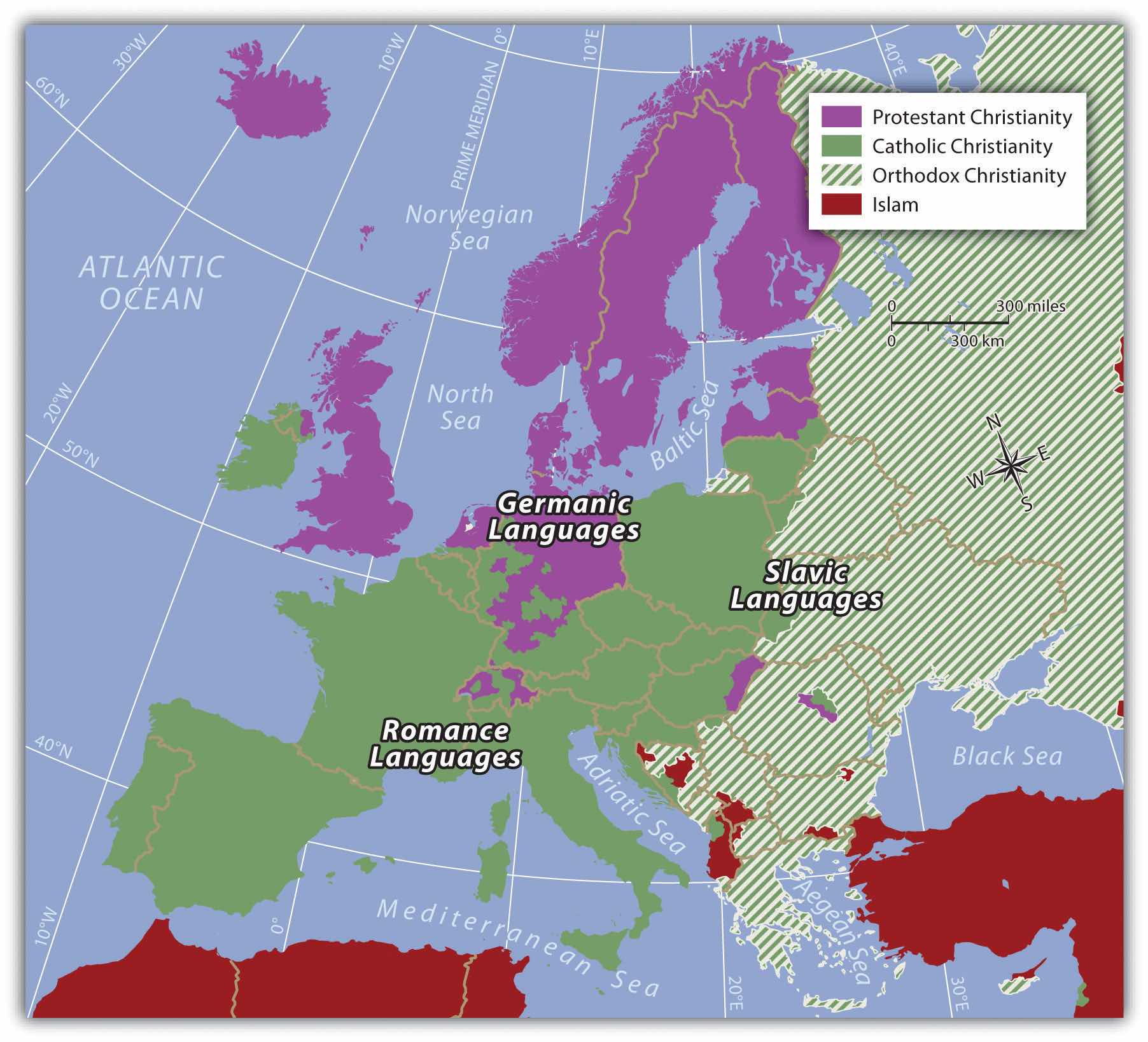
Three main Indo-European language groups dominate Europe. Though there are additional language groups, the dominant three coincide with the three main religious divisions. In the east, where the Eastern Orthodox Church is dominant, the Slavic language group prevails. In the north, along with Protestant Christianity, one finds the Germanic language group. In southern Europe, where Roman Catholicism is dominant, the Romance languages are more commonly spoken.
Identify the following key places on a map: